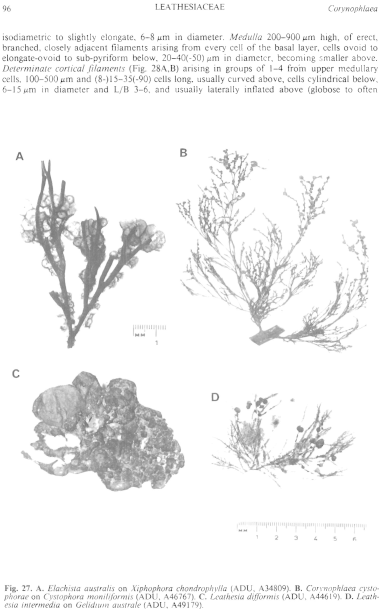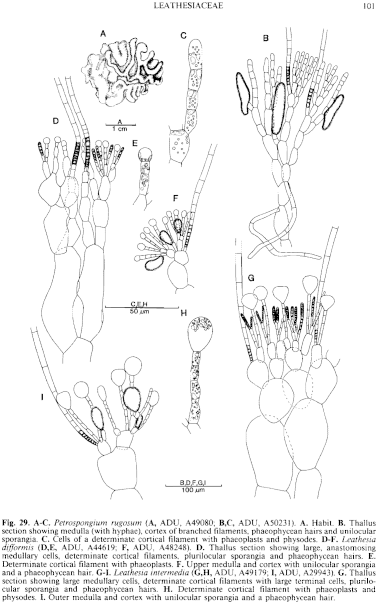|
|
|
|
|
|||||||||||
|
Electronic Flora of South Australia Species Fact Sheet
Phylum Phaeophyta – Order Chordariales – Family Leathesiaceae
Selected citations: Inagaki 1958: 101, figs 4–7. Kuckuck 1929: 44, figs 49–52. Lindauer et al. 1961: 220, fig. 44. Womersley 1967: 230.
Thallus (Fig. 27C) yellow-brown to dark brown, globose to spreading and lobed, surface smooth to rugose, firm but often becoming hollow, 10–80 mm across and 10–15 mm high, epilithic or epiphytic on larger algae or seagrasses. Basal layer of appressed radiating filaments of small cells producing erect medullary cells. Medulla (Fig. 29D) of erect, branched, filaments 4–12 mm and many cells high, with lateral anastomoses between the cells which become stellate, cells 40–80 µm in diameter below, decreasing to 15–30 µm in diameter in upper medulla, L/B 2–10, becoming subglobose just below the cortex. Determinate cortical filaments (Fig. 29D,F) arising in groups of 2–3 from upper medullary cells, forming a dense, uniform stratum 30–60 µm and 3–5 (–6) cells high, simple or basally branched; cells cylindrical or slightly inflated, 4–6 Atm in diameter and L/B 1–3, with a terminal globose to ovoid cell (6–) 8–12 (–14) µm in diameter. Phaeoplasts (Fig. 29E) several in cells of cortical filaments, discoid, apparently without a pyrenoid. Phaeophycean hairs frequent, scattered or in small groups, 8–14 µm in diameter.
Reproduction: Plurilocular sporangia (Fig. 29D) borne on a cell at base of determinate cortical filaments, single or in small clusters, simple or once branched, uniseriate, 15–30 µm and 5–8 locules long, 4–6 µm in diameter. Unilocular sporangia (Fig. 29F) borne singly from basal cell of determinate cortical filaments, ovoid to clavate, 17–30 (–40) µm long and 10–25 µm in diameter.
Type from Sweden; in LINN?
Selected specimens: Point Westall, S. Aust., on Sargassum, mid eulittoral pools (Skinner, 30.xi.1977; ADU, A48889). Aldinga, S. Aust. on Posidonia australis, lower eulittoral pools (Skinner, 14.ix.1977; ADU, A48248). Robe, S. Aust., mid eulittoral (Skinner, 13.xi.1978; ADU, A50209). Koonya Bay, Mornington Pen., Vic., lower eulittoral (Womersley, 15.i.1974; ADU, A44619-"Marine Algae of southern Australia" No.145). Crawfish Rock, Westernport Bay, Vic., low eulittoral on Gracilaria (Womersley, 29.viii.1971; ADU, A39442). Shelter Point, Boat Harbour Beach, N. Tas., mid eulittoral (Womersley, 16.x.1982; ADU, A55722). Safety Cove, Port Arthur, Tas., lower eulittoral (Skinner, 21.ii.1978; ADU, A49174).
Distribution: Widely distributed in cool temperate seas throughout the world.
In southern Australia, from Point Westall, S. Aust. to Eden, N.S.W. and around Tasmania.
Taxonomic notes: Inagaki (1958, pp. 103,104) recognises two forms, f. difformis for the spreading, lobed, epilithic and coralline-turf plants, and f. globosa for the globose, saccate epiphytes on seagrasses and some algae; they also differ in diameter of the cortical filaments. Both forms occur on southern Australian coasts, but intergrades make recognition of these two forms of restricted value.
References:
INAGAKI, K. (1958). A systematic study of the order Chordariales from Japan and its vicinity. Sci. Pap. Inst. Algol. Res. Hokkaido Univ. 4, 87–197, Plates I-XI.
KUCKUCK, P. (1929). Fragmente einer Monographie des Pheosporeen. Biol. Anst. Helgol. 17, 1–93.
LINDAUER, V.W., CHAPMAN, V.J. & AIKEN, M. (1961). The marine algae of New Zealand. II. Phaeophyceae. Nova Hedwigia 3, 129–350, Plates 57–97.
WOMERSLEY, H.B.S. (1967). A critical survey of the marine algae of southern Australia. II. Phaeophyta. Aust. J. Bot. 15, 189–270.
The Marine Benthic Flora of Southern Australia Part II complete list of references.
Publication:
Womersley, H.B.S. (14 December, 1987)
The Marine Benthic Flora of Southern Australia
Part II
©Board of the Botanic Gardens and State Herbarium, Government of South Australia
Illustrations in Womersley Part II, 1997: FIGS 27C, 29 D–F.

Figure 27 enlarge
Fig. 27. A. Elachista australis on Xiphophora chondrophylla (ADU, A34809). B. Corynophlaea cystophorae on Cystophora tnoniliformis (ADU, A46767). C. Leathesia difformis (ADU, A44619). D. Leathesia intermedia on Gelidium australe (ADU, A49179).

Figure 29 enlarge
Fig. 29. A–C. Petrospongium rugosum (A, ADU, A49080; B,C, ADU, A50231). A. Habit. B. Thallus section showing medulla (with hyphae), cortex of branched filaments, phaeophycean hairs and unilocular sporangia. C. Cells of a determinate cortical filament with phaeoplasts and physodes. D–F. Leathesia difformis (D,E, ADU, A44619; F, ADU, A48248). D. Thallus section showing large, anastomosing medullary cells, determinate cortical filaments, plurilocular sporangia and phaeophycean hairs. E. Determinate cortical filament with phaeoplasts. F. Upper medulla and cortex with unilocular sporangia and a phaeophycean hair. G–I. Leathesia intermedia (G,H, ADU, A49179; I, ADU, A29943). G. Thallus section showing large medullary cells, determinate cortical filaments with large terminal cells, plurilocular sporangia and phaeophycean hairs. H. Determinate cortical filament with phaeoplasts and physodes. I. Outer medulla and cortex with unilocular sporangia and a phaeophycean hair.

|
Email Contact: State Herbarium of South Australia |

|